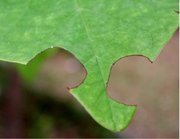Megachilidae
|
|
| Megachilidae | ||||||||||||||||||||||
|---|---|---|---|---|---|---|---|---|---|---|---|---|---|---|---|---|---|---|---|---|---|---|
| Missing image Megachile_centuncularis.jpg A leaf-cutter bee | ||||||||||||||||||||||
| Scientific classification | ||||||||||||||||||||||
| ||||||||||||||||||||||
| Subfamilies | ||||||||||||||||||||||
|
Fideliinae |
The Megachilidae are a cosmopolitan family of (mostly) solitary bees that carry pollen in specialized structures called scopae located under the abdomen (rather than on the hind legs like in the honey bee). Many megachilid genera are commonly known as mason and leaf cutter bees, reflecting the materials they build their nest cells from (clay or leaves, respectively). Most species feed on nectar and pollen, but some (known as cuckoo bees) are brood parasites. Parasitic species do not possess pollen-collecting organs.
Note: Some authors place all the bees into the family Apidae. See for example this AMNH page (http://research.amnh.org/entomology/social_insects/training/hymintro.html).
North America has many native Megachilid species, but Alfalfa leafcutter bees (Megachile rotundata) are an imported species used for pollination.
| Contents |
Life Cycle
Non-parasitic species
The general life cycle of non-parasitic Megachilidae is as follows (but see below for variations):
The female builds a nest for her brood. The nests are divided into cells, each cell receives a supply of food (pollen or a pollen/nectar mix) and an egg. The larva hatches from the egg and consumes the food supply. After moulting a few times, it spins a cocoon and pupates. Then it emerges from the nest as an adult. Males die shortly after mating, but females survive for another few weeks, during which they build new nests. After finding a suitable spot (often near where she emerged), she starts builds a first cell, supplies it with food, and lays an egg in it. Then she builds a wall that separates the completed cell from the next one.
Variations:
- Nests are often (but not always) built in natural or artificial cavities. Some embed individual cells in a mass of clay deposited against a wall.
- Nest cavities are often linear, for example in hollow plant stems, but not always (snail shells are used by some Osmia, and some species will readily use irregular cavities).
Parasitic species
Some genera of Megachilids are brood parasites, often on related species. They typically enter the nest before it is sealed and lay their eggs in a cell. After hatching, the parasite larva consumes the host's food, eventually resulting in the host larva's death by starvation.
Genera of Megachilidae
Coelioxys7341.JPG
- Anthidium are mason bees who use conifer resin, plant hairs, earth, or a combination of these as material for the nest walls.
- Coelioxys are brood parasites of Megachile.
- Dioxys are brood parasites of Megachile, Anthidium and Osmia.
- Heriades are mason bees. They resemble small Osmia, but they are oligolectic (specialized on a few subfamilies of Asteraceae) and use resin from conifers, as well as plant fibers and sand, as cell wall material.
- Megachile are mostly leaf-cutters, but some are masons. In these species the whole cell (not just the wall between cells) is made from a piece of leaf.
- Osmia are mason bees, they build their nests in natural or artificial cavities such as hollow plant stems, abandoned nests of wood-boring beetles or carpenter bees, or snail shells. They do not excavate their own nests. The material used for the cell can be clay or chewed plant tissue.
- Stelis Panzer, or the stelidine bees, are parasitic species on other Megachilidae. They belong to the tribe Anthidini.
Resources
- Photos of orchard mason bees (http://www.pollinator.com/gallery/mason_nest.htm)
- Managing megachilid bees for blueberry pollination (http://wildblueberries.maine.edu/FactSheets/301.htm)
Osmia_ribifloris_bee.jpg

